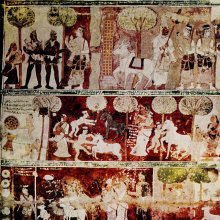Nandagopa, Nanda-Gopa, Nandagopā: 6 definitions
Introduction:
Nandagopa means something in Buddhism, Pali, Hinduism, Sanskrit. If you want to know the exact meaning, history, etymology or English translation of this term then check out the descriptions on this page. Add your comment or reference to a book if you want to contribute to this summary article.
Images (photo gallery)
In Hinduism
Purana and Itihasa (epic history)
Source: archive.org: Puranic EncyclopediaNandagopa (नन्दगोप).—Foster-father of Śrī Kṛṣṇa. Previous birth. There are two stories about the previous birth of Nandagopa. (See full article at Story of Nandagopa from the Puranic encyclopaedia by Vettam Mani)
Source: Cologne Digital Sanskrit Dictionaries: The Purana IndexNandagopa (नन्दगोप).—See Nanda.*
- * Brahmāṇḍa-purāṇa III. 71. 212; Vāyu-purāṇa 96. 206.
Nandagopa (नन्दगोप).—See Nanda.*
- * Brahmāṇḍa-purāṇa III. 71. 212; Vāyu-purāṇa 96. 206.

The Purana (पुराण, purāṇas) refers to Sanskrit literature preserving ancient India’s vast cultural history, including historical legends, religious ceremonies, various arts and sciences. The eighteen mahapuranas total over 400,000 shlokas (metrical couplets) and date to at least several centuries BCE.
In Buddhism
Theravada (major branch of Buddhism)
Source: Pali Kanon: Pali Proper NamesA serving woman of Devagabbha.
Her husband was Andhakavenu. She bore ten daughters, their births coinciding with those of ten sons to Devagabbha, and exchanged her daughters for the latters sons.
These, because they were adopted by her husband, came to be known as Andhavenhudasaputta. J.iv.79ff.
Theravāda is a major branch of Buddhism having the the Pali canon (tipitaka) as their canonical literature, which includes the vinaya-pitaka (monastic rules), the sutta-pitaka (Buddhist sermons) and the abhidhamma-pitaka (philosophy and psychology).
Languages of India and abroad
Sanskrit dictionary
Source: Cologne Digital Sanskrit Dictionaries: Monier-Williams Sanskrit-English DictionaryNandagopa (नन्दगोप):—[=nanda-gopa] [from nanda > nand] m. the cowherd N°'s, [Harivaṃśa]
[Sanskrit to German]
Sanskrit, also spelled संस्कृतम् (saṃskṛtam), is an ancient language of India commonly seen as the grandmother of the Indo-European language family (even English!). Closely allied with Prakrit and Pali, Sanskrit is more exhaustive in both grammar and terms and has the most extensive collection of literature in the world, greatly surpassing its sister-languages Greek and Latin.
See also (Relevant definitions)
Starts with: Nandagopakula, Nandagopakulodbhava, Nandagopakumara.
Full-text: Nandagopakulodbhava, Nandagopakumara, Nandagopakula, Andhakavenhu, Punyashravas, Yashoda, Brihadvana, Dhara, Devagabbha, Kshattri, Trinavarta, Mathura, Nanda, Vacya, Andhakavenhu Putta, Gopa, Sudarshana.
Relevant text
Search found 19 books and stories containing Nandagopa, Nanda-gopa, Nandagopā; (plurals include: Nandagopas, gopas, Nandagopās). You can also click to the full overview containing English textual excerpts. Below are direct links for the most relevant articles:
Garga Samhita (English) (by Danavir Goswami)
Verse 1.18.2 < [Chapter 18 - Vision of the Universal Form]
Verse 6.1.1 < [Chapter 1 - Jarāsandha’s Defeat]
Verse 6.2.26 < [Chapter 2 - Residence in Śrī Dvārakā]
The Jataka tales [English], Volume 1-6 (by Robert Chalmers)
Jataka 454: Ghata-jātaka < [Volume 4]
Puranic encyclopaedia (by Vettam Mani)
Bhakti-rasamrta-sindhu (by Śrīla Rūpa Gosvāmī)
Verse 2.1.293 < [Part 1 - Ecstatic Excitants (vibhāva)]
Verse 2.4.25 < [Part 4 - Transient Ecstatic Disturbances (vyābhicāri-bhāva)]
Chaitanya Bhagavata (by Bhumipati Dāsa)
Verse 3.3.406 < [Chapter 3 - Mahāprabhu’s Deliverance of Sarvabhauma, Exhibition of His Six-armed Form, and Journey to Bengal]
Tiruvaymoli (Thiruvaimozhi): English translation (by S. Satyamurthi Ayyangar)
Pasuram 8.1.3 < [Section 1 - First Tiruvaymoli (Tevimar avar)]
